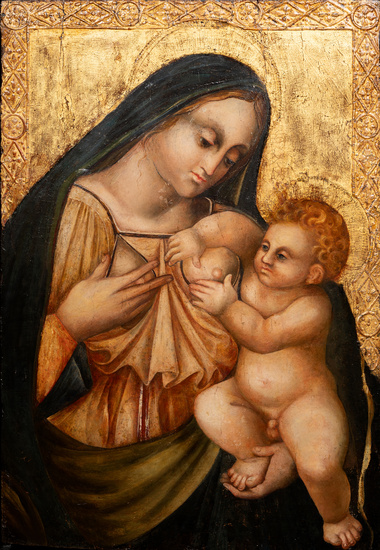Italian school, XV century.
Italian school, XV century.
"Virgin of the Milk".
Tempera on wood. Golden background.
It has slight flaws in the pictorial layer.
Measurements: 60 x 41 cm; 63 x 44,5 cm (frame).
Devotional image of remarkable quality, representing the Virgin of half a body with the Child, in her invocation of the Virgin of the Milk (also called Virgin of the grotto of Bethlehem). Stylistically, it is at the hinge between late Gothic and Quattrocento. This can be seen in the coexistence of medieval elements (the golden background, the emotional distance between the Child and the Virgin, the geometric reduction in the drawing of the folds...) and an incipient Renaissance: emergence of the naturalistic treatment in the fleshy countenances, in the humanized gesture of the little one, etc. It emphasizes the chromatic and luminous brilliance achieved with the tempera technique.
The Virgin of Bethlehem or of the grotto of Bethlehem is an invocation and an iconography of the Virgin Mary, in which she is represented in the act of suckling the Baby Jesus. This representation has had various developments in sacred art, such as painting, sculpture and the particular iconography of the Orthodox Church. The representation of the Virgin suckling the baby Jesus is mentioned by Pope Gregory the Great, a mosaic with this representation probably dating back to the 12th century is found on the façade of the Basilica of Santa Maria in Trastevere, although a few other examples from the early Middle Ages still survive. It is considered that this invocation may be a syncretism of the mother-goddesses, in particular of the goddess Isis suckling Horus, and probably the earliest images appeared in Coptic art. The Milk Grotto is a place in Bethlehem, very close to the Basilica of the Nativity, where tradition says that the Virgin suckled the Child, and a drop spilled on a rock, which changed its color, becoming white. Because of this, stones from the grotto (made of calcium carbonate) were considered relics in the early centuries because, when diluted in water, the water took on the appearance of milk. The sanctuary erected in this place is used by women who ask the Virgin to improve the quality of their mother's milk.
HELP
View it on
Estimate
Time
Auction House
Italian school, XV century.
"Virgin of the Milk".
Tempera on wood. Golden background.
It has slight flaws in the pictorial layer.
Measurements: 60 x 41 cm; 63 x 44,5 cm (frame).
Devotional image of remarkable quality, representing the Virgin of half a body with the Child, in her invocation of the Virgin of the Milk (also called Virgin of the grotto of Bethlehem). Stylistically, it is at the hinge between late Gothic and Quattrocento. This can be seen in the coexistence of medieval elements (the golden background, the emotional distance between the Child and the Virgin, the geometric reduction in the drawing of the folds...) and an incipient Renaissance: emergence of the naturalistic treatment in the fleshy countenances, in the humanized gesture of the little one, etc. It emphasizes the chromatic and luminous brilliance achieved with the tempera technique.
The Virgin of Bethlehem or of the grotto of Bethlehem is an invocation and an iconography of the Virgin Mary, in which she is represented in the act of suckling the Baby Jesus. This representation has had various developments in sacred art, such as painting, sculpture and the particular iconography of the Orthodox Church. The representation of the Virgin suckling the baby Jesus is mentioned by Pope Gregory the Great, a mosaic with this representation probably dating back to the 12th century is found on the façade of the Basilica of Santa Maria in Trastevere, although a few other examples from the early Middle Ages still survive. It is considered that this invocation may be a syncretism of the mother-goddesses, in particular of the goddess Isis suckling Horus, and probably the earliest images appeared in Coptic art. The Milk Grotto is a place in Bethlehem, very close to the Basilica of the Nativity, where tradition says that the Virgin suckled the Child, and a drop spilled on a rock, which changed its color, becoming white. Because of this, stones from the grotto (made of calcium carbonate) were considered relics in the early centuries because, when diluted in water, the water took on the appearance of milk. The sanctuary erected in this place is used by women who ask the Virgin to improve the quality of their mother's milk.
HELP



